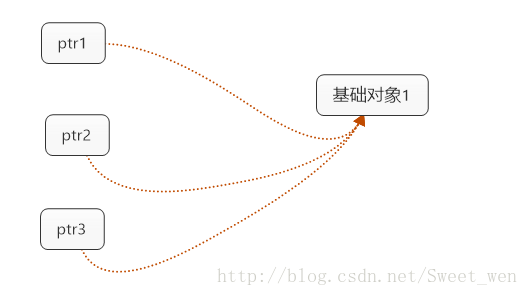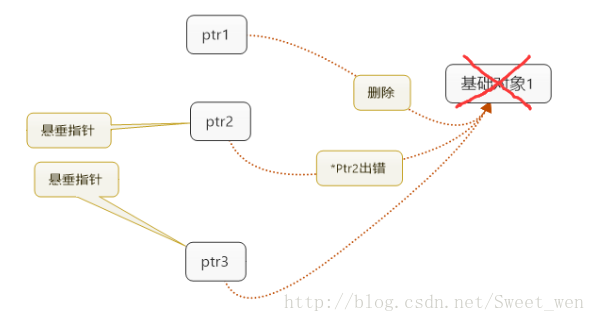1.引入
|
1
2
3
4
5
6
|
int main(){ int *p = new int; //裸指针 delete p; return 0;} |
在上面的代码中定义了一个裸指针p,需要我们手动释放。如果我们一不小心忘记释放这个指针或者在释放这个指针之前,发生一些异常,会造成严重的后果(内存泄露)。而智能指针也致力于解决这种问题,使程序员专注于指针的使用而把内存管理交给智能指针。
普通指针也容易出现指针悬挂问题,当有多个指针指向同一个对象的时候,如果某一个指针delete了这个对象,所以这个指针不会对这个对象进行操作,那么其他指向这个对象的指针呢?还在等待已经被删除的基础对象并随时准备对它进行操作。于是悬垂指针就形成了,程序崩溃也“指日可待”。
|
1
2
3
4
5
6
7
8
9
10
11
12
|
int main(){ int *p1 = new int(2); int *p2 = p1; int *p3 = p2; cout<<*p1<<endl; cout<<*p2<<endl; cout<<*p3<<endl; delete p1; cout<<*p2<<endl; return 0;} |
输出结果
|
1
2
3
4
|
222-572662307 |
输出的结果*p2的结果并不是期待中2,因为2早已经被删除了。


智能指针
智能指针是一个类,它把普通指针封装起来,能实现和普通指针同样的功能。不同的是智能指针能够对内存进行自动管理,利用类对象出了作用域会调用析构函数,把对指针的释放写在析构函数中,避免出现悬挂指针的情况。
智能指针(smart pointer)是存储指向动态分配(堆)对象指针的类,用于生存期控制,能够确保自动正确的销毁动态分配的对象,防止内存泄露。它的一种通用实现技术是使用引用计数(reference count)。智能指针类将一个计数器与类指向的对象相关联,引用计数跟踪该类有多少个对象共享同一指针。每次创建类的新对象时,初始化指针并将引用计数置为1;当对象作为另一对象的副本而创建时,拷贝构造函数拷贝指针并增加与之相应的引用计数;对一个对象进行赋值时,赋值操作符减少左操作数所指对象的引用计数(如果引用计数为减至0,则删除对象),并增加右操作数所指对象的引用计数;调用析构函数时,构造函数减少引用计数(如果引用计数减至0,则删除基础对象)。
智能指针就是模拟指针动作的类。所有的智能指针都会重载 -> 和 * 操作符。智能指针还有许多其他功能,比较有用的是自动销毁。这主要是利用栈对象的有限作用域以及临时对象(有限作用域实现)析构函数释放内存。当然,智能指针还不止这些,还包括复制时可以修改源对象等。智能指针根据需求不同,设计也不同(写时复制,赋值即释放对象拥有权限、引用计数等,控制权转移等)。auto_ptr 即是一种常见的智能指针。
智能指针的实现(用类模板实现)
|
1
2
3
4
5
6
7
8
9
10
11
12
13
14
15
16
17
18
19
20
21
22
23
24
25
26
27
28
29
30
31
32
33
34
35
36
37
38
39
40
41
42
43
44
45
46
47
48
49
50
51
52
53
54
55
56
57
|
class Test{public: Test() { cout<<"Test()"<<endl; } ~Test() { cout<<"~Test()"<<endl; } void func() { cout<<"call Test::func()"<<endl; }};template<typename T>class CSmartptr{public: CSmartptr(T *ptr):_ptr(ptr) {cout<<"CSmartptr()"<<endl;} CSmartptr(const CSmartptr<T> &other) { _ptr = new T; *ptr = *other._ptr; } ~CSmartptr() { cout<<"~CSmartptr()"<<endl; delete _ptr; } void relase() const { ((CSmartptr<T> *)this)->owns = false; } T& operator*() { return *_ptr; } const T& operator*()const {return *_ptr;} T *operator->() { return _ptr; } const T *operator->()const {return _ptr;}private: T *_ptr;};int main(){ CSmartptr<int> p1(new int); *p1 = 200; CSmartptr<Test> p2(new Test); p2->func(); return 0;} |
模拟实现auto_ptr
|
1
2
3
4
5
6
7
8
9
10
11
12
13
14
15
16
17
18
19
20
21
22
23
24
25
26
27
28
29
30
31
32
33
34
35
36
37
38
39
40
41
42
43
44
45
46
|
template<typename T>class CSmartptr{public: CSmartptr(T *ptr):_ptr(ptr),owns(true){cout<<"CSmartptr()"<<endl;} CSmartptr(const CSmartptr<T> &other) { other.relase(); _ptr = other._ptr; } ~CSmartptr() { cout<<"~CSmartptr()"<<endl; if( owns == true) { cout<<"~CSmartptr()"<<endl; delete _ptr; } } void relase() const { ((CSmartptr<T> *)this)->owns = false; } T& operator*() { return *_ptr; } const T& operator*()const {return *_ptr;} T *operator->() { return _ptr; } const T *operator->()const {return _ptr;}private: T *_ptr; bool owns; //标志位 ,控制一个资源的访问权限};int main(){ CSmartptr<int> p1(new int); *p1 = 200; CSmartptr<Test> p2(new Test); p2->func(); return 0;} |
带有引用计数的智能指针(方便对资源的管理和释放)
|
1
2
3
4
5
6
7
8
9
10
11
12
13
14
15
16
17
18
19
20
21
22
23
24
25
26
27
28
29
30
31
32
33
34
35
36
37
38
39
40
41
42
43
44
45
46
47
48
49
50
51
52
53
54
55
56
57
58
59
60
61
62
63
64
65
66
67
68
69
70
71
72
73
74
75
76
77
78
79
80
81
82
83
84
85
86
87
88
89
90
91
92
93
94
95
96
97
98
99
100
101
102
103
104
105
106
107
108
109
110
111
112
113
114
115
116
117
118
119
120
121
122
123
124
125
126
127
128
129
130
131
132
|
class CHeapTable{public: static CHeapTable& getInstance() { return mHeapTable; } //增加引用计数 void addRef(void *ptr) { pthread_mutex_lock(mutex); list<Node>::iterator it = find(mList.begin(), mList.end(), ptr); // Node == Node it->mpaddr if(it == mList.end()) { mList.push_front(ptr); cout<<"new addr:"<<ptr<<" ref:"<<1<<endl; } else { it->mcount++; cout<<"add addr:"<<ptr<<" ref:"<<it->mcount<<endl; } pthread_mutex_unlock(mutex); } //减少引用计数的 void delRef(void *ptr) { list<Node>::iterator it = find(mList.begin(), mList.end(), ptr); if(it != mList.end()) { it->mcount--; cout<<"del addr:"<<ptr<<" ref:"<<it->mcount<<endl; if(it->mcount == 0) { mList.erase(it); } } } //获取引用计数的 int getRef(void *ptr) { list<Node>::iterator it = find(mList.begin(), mList.end(), ptr); if(it != mList.end()) { return it->mcount; } return 0; }private: CHeapTable(){} static CHeapTable mHeapTable; struct Node { Node(void *ptr=NULL):mpaddr(ptr),mcount(1){} bool operator==(const Node &src) { return mpaddr == src.mpaddr; } void *mpaddr; //标识堆内存资源 int mcount; //标识资源的引用计数 }; list<Node> mList;};CHeapTable CHeapTable::mHeapTable;template<typename T>class CSmartPtr{public: CSmartPtr(T *ptr = NULL) :mptr(ptr) { if(mptr != NULL) { addRef(); } } ~CSmartPtr() { delRef(); if(0 == getRef()) { delete mptr; mptr = NULL; } } CSmartPtr(const CSmartPtr<T> &src) :mptr(src.mptr) { if(mptr != NULL) { addRef(); } } CSmartPtr<T>& operator=(const CSmartPtr<T> &src) { if(this == &src) return *this; delRef(); if(0 == getRef()) { delete mptr; mptr = NULL; } mptr = src.mptr; if(mptr != NULL) { addRef(); } } T& operator*(){return *mptr;} const T& operator*()const{return *mptr;} T* operator->(){return mptr;} const T* operator->()const{return mptr;} void addRef(){mHeapTable.addRef(mptr);} void delRef(){mHeapTable.delRef(mptr);} int getRef(){return mHeapTable.getRef(mptr);}private: T *mptr; static CHeapTable &mHeapTable;};template<typename T>CHeapTable& CSmartPtr<T>::mHeapTable = CHeapTable::getInstance(); |
以上就是智能指针的实例详解,如有疑问请留言或者到本站社区交流讨论,感谢阅读,希望能帮助到大家,谢谢大家对本站的支持
原文链接:http://blog.csdn.net/sweet_wen/article/details/76022274














